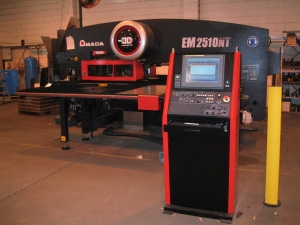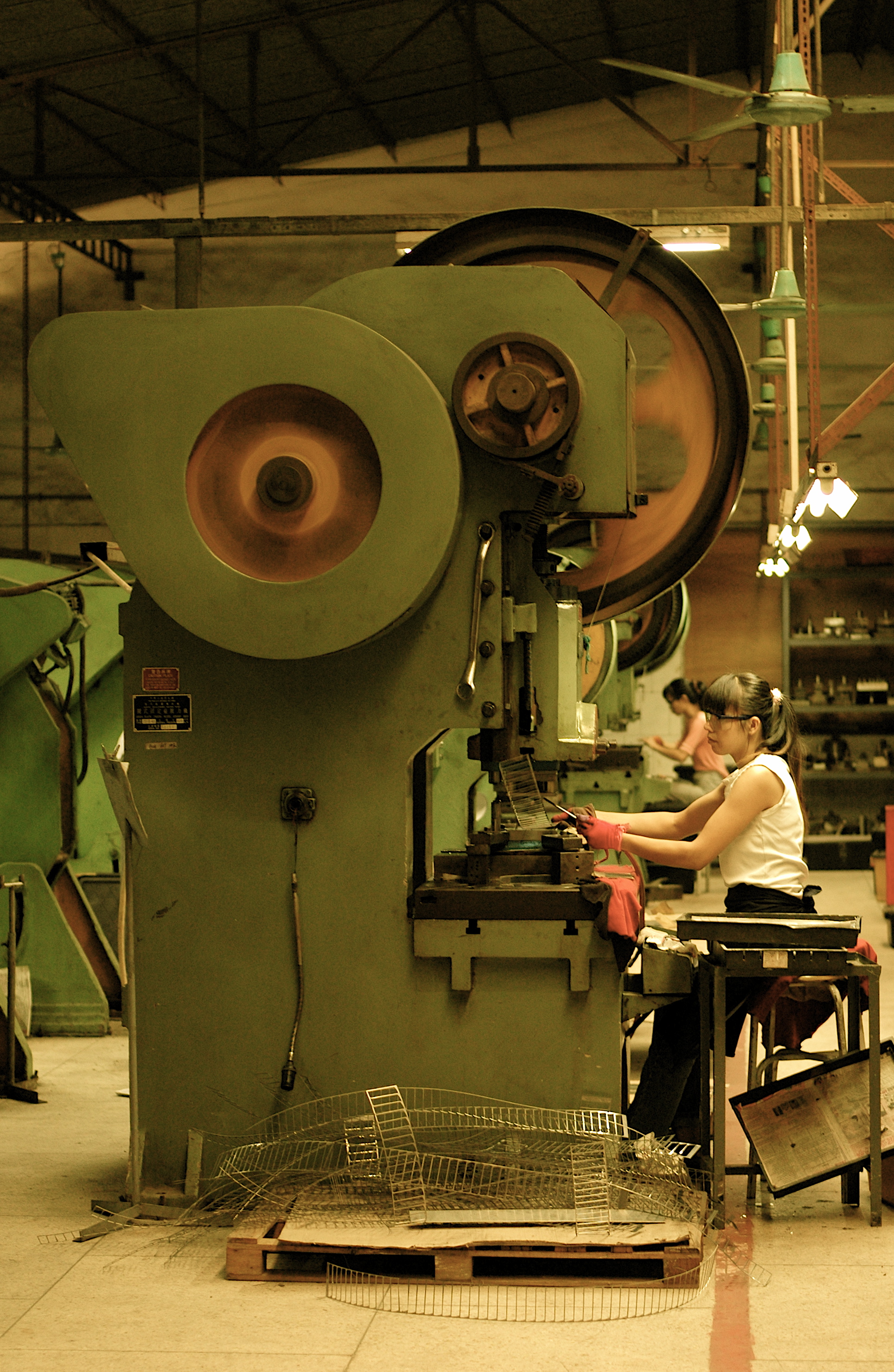|
Turret Punch
A turret punch or turret press is a type of punch press used for metal forming by punching. Punching, and press work in general, is a process well suited to mass production. However the initial tooling costs, of both the machine and the job-specific press tool, are high. This limits punch work from being used for much small-volume and prototype work. A turret punch is one way of addressing this cost. The tooling of a turret punch uses a large number of standard punch tools: holes of varying sizes, straight edges, commonly-used notches or mounting holes. By using a large number of strokes, with several different tools in turn, a turret press may make a wide variety of parts without having to first make a specialised press tool for that task. This saves both time and money, allowing rapid prototyping or for low volume production to start without tooling delays. A typical CNC turret punch has a choice of up to 60 tools in a "turret" that can be rotated to bring any tool to the p ... [...More Info...] [...Related Items...] OR: [Wikipedia] [Google] [Baidu] |
Punch Press
A punch press is a type of machine press used to cut holes in material. It can be small and manually operated and hold one simple die set, or be very large, CNC operated, with a multi-station turret and hold a much larger and complex die set. Description Punch presses are large machines with either a 'C' type frame, or a 'portal' (bridge) type frame. The ''C'' type has the hydraulic ram at the top foremost part, whereas the portal frame is much akin to a complete circle with the ram being centered within the frame to stop frame deflection or distortion. C type presses have a bed plate which is used to lock the die bottom bolster. For locking the die, T-bolts are used and so this plate contains T-slots into which T-bolts are slid in. These slots are placed diagonally and with a slot horizontal to the longer side of the plate, is the general practice. These slots run up to a central hole made in the plate, the hole being large enough to accommodate another bush with a hole, the h ... [...More Info...] [...Related Items...] OR: [Wikipedia] [Google] [Baidu] |
Metal Forming
Forming, metal forming, is the metalworking process of fashioning metal parts and objects through mechanical deformation; the workpiece is reshaped without adding or removing material, and its mass remains unchanged. Forming operates on the materials science principle of plastic deformation, where the physical shape of a material is permanently deformed. Characteristics Metal forming tends to have more uniform characteristics across its subprocesses than its contemporary processes, cutting and joining. On the industrial scale, forming is characterized by: * Very high loads and stresses required, between 50 and () * Large, heavy, and expensive machinery in order to accommodate such high stresses and loads * Production runs with many parts, to maximize the economy of production and compensate for the expense of the machine tools Forming processes Forming processes tend to be categorised by differences in effective stresses. These categories and descriptions are highly simplif ... [...More Info...] [...Related Items...] OR: [Wikipedia] [Google] [Baidu] |
Punching
Punching is a forming process that uses a punch press to force a tool, called a ''punch'', through the workpiece to create a hole via shearing. Punching is applicable to a wide variety of materials that come in sheet form, including sheet metal, paper, vulcanized fibre and some forms of plastic sheet. The punch often passes through the work into a die. A scrap slug from the hole is deposited into the die in the process. Depending on the material being punched this slug may be recycled and reused or discarded. Punching is often the cheapest method for creating holes in sheet materials in medium to high production volumes. When a specially shaped punch is used to create multiple usable parts from a sheet of material the process is known as blanking. In metal forging applications the work is often punched while hot, and this is called hot punching. Slugging is the operation of punching in which the punch is stopped as soon as the metal fracture is complete and metal is not remo ... [...More Info...] [...Related Items...] OR: [Wikipedia] [Google] [Baidu] |
Laser Cutter
A laser is a device that emits light through a process of optical amplification based on the stimulated emission of electromagnetic radiation. The word "laser" is an acronym for "light amplification by stimulated emission of radiation". The first laser was built in 1960 by Theodore H. Maiman at Hughes Research Laboratories, based on theoretical work by Charles Hard Townes and Arthur Leonard Schawlow. A laser differs from other sources of light in that it emits light which is ''coherent''. Spatial coherence allows a laser to be focused to a tight spot, enabling applications such as laser cutting and lithography. Spatial coherence also allows a laser beam to stay narrow over great distances (collimation), enabling applications such as laser pointers and lidar (light detection and ranging). Lasers can also have high temporal coherence, which allows them to emit light with a very narrow spectrum. Alternatively, temporal coherence can be used to produce ultrashort pulses of ligh ... [...More Info...] [...Related Items...] OR: [Wikipedia] [Google] [Baidu] |
Computer-aided Manufacturing
Computer-aided manufacturing (CAM) also known as computer-aided modeling or computer-aided machining is the use of software to control machine tools in the manufacturing of work pieces. This is not the only definition for CAM, but it is the most common; CAM may also refer to the use of a computer to assist in all operations of a manufacturing plant, including planning, management, transportation and storage. Its primary purpose is to create a faster production process and components and tooling with more precise dimensions and material consistency, which in some cases, uses only the required amount of raw material (thus minimizing waste), while simultaneously reducing energy consumption. CAM is now a system used in schools and lower educational purposes. CAM is a subsequent computer-aided process after computer-aided design (CAD) and sometimes computer-aided engineering (CAE), as the model generated in CAD and verified in CAE can be input into CAM software, which then controls t ... [...More Info...] [...Related Items...] OR: [Wikipedia] [Google] [Baidu] |
Computer-aided Design
Computer-aided design (CAD) is the use of computers (or ) to aid in the creation, modification, analysis, or optimization of a design. This software is used to increase the productivity of the designer, improve the quality of design, improve communications through documentation, and to create a database for manufacturing. Designs made through CAD software are helpful in protecting products and inventions when used in patent applications. CAD output is often in the form of electronic files for print, machining, or other manufacturing operations. The terms computer-aided drafting (CAD) and computer aided design and drafting (CADD) are also used. Its use in designing electronic systems is known as '' electronic design automation'' (''EDA''). In mechanical design it is known as ''mechanical design automation'' (''MDA''), which includes the process of creating a technical drawing with the use of computer software. CAD software for mechanical design uses either vector-based graphic ... [...More Info...] [...Related Items...] OR: [Wikipedia] [Google] [Baidu] |
Press Brake
A press brake is a machine used for bending sheet metal and metal plate, most commonly sheet metal. It forms predetermined bends by clamping the workpiece between a matching top tool and bottom die.Parker, Dana T. ''Building Victory: Aircraft Manufacturing in the Los Angeles Area in World War II,'' p. 29, 83, Cypress, CA, 2013. ISBN 978-0-9897906- 0-4. Typically, two C-frames form the sides of the press brake, connected to a table at the bottom and on a movable beam at the top. The bottom tool is mounted on the table, with the top tool mounted on the upper beam. Types A brake can be described by basic parameters, such as the force or tonnage and the working length. Additional parameters include the stroke length, the distance between the frame uprights or side housings, distance to the back gauge, and work height. The upper beam usually operates at a speed ranging from 1 to 15 mm/s. There are several types of press brakes including nut-stop hydraulic, synchro hydraulic, ele ... [...More Info...] [...Related Items...] OR: [Wikipedia] [Google] [Baidu] |
English Wheel
The English wheel, in Britain also known as a wheeling machine, is a metalworking tool that enables a craftsperson to form compound (double curvature) curves from flat sheets of metal such as aluminium or steel.Parker, Dana T. ''Building Victory: Aircraft Manufacturing in the Los Angeles Area in World War II,'' p. 89, Cypress, CA, 2013. . Description The process of using an English wheel is known as wheeling. Panels produced this way are expensive, due to the highly skilled and labour-intensive production method, but it has the key advantage that it can flexibly produce different panels using the same machine. It is a forming machine that works by surface stretching and is related in action to panel beating processes. It is used wherever low volumes of compound curved panels are required; typically in coachbuilding, car restoration, spaceframe chassis racing cars that meet regulations that require sheetmetal panels resembling mass production vehicles (NASCAR), car prototypes and ... [...More Info...] [...Related Items...] OR: [Wikipedia] [Google] [Baidu] |
Metalworking Tools
Metalworking is the process of shaping and reshaping metals to create useful objects, parts, assemblies, and large scale structures. As a term it covers a wide and diverse range of processes, skills, and tools for producing objects on every scale: from huge ships, buildings, and bridges down to precise engine parts and delicate jewelry. The historical roots of metalworking predate recorded history; its use spans cultures, civilizations and millennia. It has evolved from shaping soft, native metals like gold with simple hand tools, through the smelting of ores and hot forging of harder metals like iron, up to highly technical modern processes such as machining and welding. It has been used as an industry, a driver of trade, individual hobbies, and in the creation of art; it can be regarded as both a science and a craft. Modern metalworking processes, though diverse and specialized, can be categorized into one of three broad areas known as forming, cutting, or joining processes. Mo ... [...More Info...] [...Related Items...] OR: [Wikipedia] [Google] [Baidu] |
Machine Tools
A machine tool is a machine for handling or machining metal or other rigid materials, usually by cutting, boring, grinding, shearing, or other forms of deformations. Machine tools employ some sort of tool that does the cutting or shaping. All machine tools have some means of constraining the work piece and provide a guided movement of the parts of the machine. Thus, the relative movement between the workpiece and the cutting tool (which is called the toolpath) is controlled or constrained by the machine to at least some extent, rather than being entirely "offhand" or " freehand". It is a power-driven metal cutting machine which assists in managing the needed relative motion between cutting tool and the job that changes the size and shape of the job material. The precise definition of the term ''machine tool'' varies among users, as discussed below. While all machine tools are "machines that help people to make things", not all factory machines are machine tools. Today mach ... [...More Info...] [...Related Items...] OR: [Wikipedia] [Google] [Baidu] |






